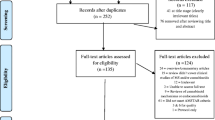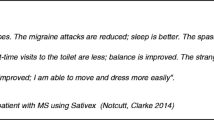Abstract
This is an exciting time for cannabinoid research. Evidence suggests that cannabis (marijuana) can alleviate symptoms like muscle spasticity and pain in patients with multiple sclerosis (MS). Interest in the field of cannabinoids has been strengthened by the identification and cloning of cannabinoid receptors located in the central nervous system and the peripheral immune organs, and by the discovery of the endogenous cannabinoid ligands. Cannabinoids are also efficacious in animal models of MS. However, there have been only ten published clinical reports on the use of cannabis in MS, involving 78 individuals worldwide, and the results have been equivocal. Researchers encounter a number of difficulties in designing clinical studies that use cannabinoids. From the studies reporting the use of cannabinoids in MS patients with spasticity, the somewhat better designed studies failed to demonstrate objective improvement. Therefore, convincing evidence that cannabinoids are effective in MS is still lacking.


Similar content being viewed by others
Notes
The use of tradenames is for product identification purposes only and does not imply endorsement.
References
Francis G. Marijuana use in multiple sclerosis. In: Nahas GG, Sutin KM, Harvey DJ, et al., editors. Marijuana and medicine. Totowa (NJ): Humana Press Inc., 1999: 631–7
Polman CH, Uitdehaag BM. Drug treatment of multiple sclerosis. BMJ 2000; 321(725): 490–4
Consroe P. Brain cannabinoid systems as targets for the therapy of neurological disorders. Neurobiol Dis 1998; 5 (6 Pt B): 534–51
Pertwee RG. Cannabinoids and multiple sclerosis. Pharmacol Ther 2002; 95(2): 165–74
Zajicek J. Cannabinoids on trial for multiple sclerosis [letter]. Lancet Neurol 2002; 1(3): 147
Williamson EM, Evans FJ. Cannabinoids in clinical practice. Drugs 2000; 60(6): 1303–14
Killestein J, Hoogervorst EL, Polman CH. Therapeutic uses of cannabinoids in MS. Int MS J 2002; 9(2): 64–70
Mechoulam R. Marihuana chemistry. Science 1970; 168(936): 1159–66
Mechoulam R, Parker LA, Gallily R. Cannabidiol: an overview of some pharmacological aspects. J Clin Pharmacol 2002; 42 (11 Suppl.): 11S–9S
Matsuda LA, Lolait SJ, Brownstein MJ, et al. Structure of a cannabinoid receptor and functional expression of the cloned cDNA. Nature 1990; 346(6284): 561–4
Munro S, Thomas KL, Abu-Shaar M. Molecular characterization of a peripheral receptor for cannabinoids. Nature 1993; 365(6441): 61–5
Devane WA, Hanus L, Breuer A, et al. Isolation and structure of a brain constituent that binds to the cannabinoid receptor. Science 1992; 258(5090): 1946–9
Mechoulam R, Ben Shabat S, Hanus L, et al. Identification of an endogenous 2-monoglyceride, present in canine gut, that binds to cannabinoid receptors. Biochem Pharmacol 1995; 50(1): 83–90
Herkenham M, Lynn AB, Little MD, et al. Cannabinoid receptor localization in brain. Proc Natl Acad sci U S A 1990; 87(5): 1932–6
Westlake TM, Howlett AC, Bonner TI, et al. Cannabinoid receptor binding and messenger RNA expression in human brain: an in vitro receptor autoradiography and in situ hybridization histochemistry study of normal aged and Alzheimer’s brains. Neuroscience 1994; 63(3): 637–52
Croxford JL. Therapeutic potential of cannabinoids in CNS disease. CNS Drugs 2003; 17(3): 179–202
Howlett AC, Barth F, Bonner TI, et al. International Union of Pharmacology. XXVII: classification of cannabinoid receptors. Pharmacol Rev 2002; 54(2): 161–202
Fride E, Foox A, Rosenberg E, et al. Milk intake and survival in newborn cannabinoid CB (1) receptor knockout mice: evidence for a “CB (3)” receptor. Eur J Pharmacol 2003; 461(1): 27–34
Wilson RI, Nicoll RA. Endocannabinoid signaling in the brain. Science 2002; 296(5568): 678–82
Wiley JL, Martin BR. Cannabinoid pharmacology: implications for additional cannabinoid receptor subtypes. Chem Phys Lipids 2002; 121(1–2): 57–63
Iversen LL. The pharmacology of THC, the psychoactive ingredient in cannabis: the science of marijuana. Oxford: Oxford University Press, 2001: 29–76
Lyman WD, Abrams GA, Raine CS. Experimental autoimmune encephalomyelitis: isolation and characterization of inflammatory cells from the central nervous system. J Neuroimmunol 1989; 25(2–3): 195–201
Lyman WD, Sonett JR, Brosnan CF, et al. Delta 9-tetrahydro-cannabinol: a novel treatment for experimental autoimmune encephalomyelitis. J Neuroimmunol 1989; 23(1): 73–81
Wirguin I, Mechoulam R, Breuer A, et al. Suppression of experimental autoimmune encephalomyelitis by cannabinoids. Immunopharmacology 1994; 28(3): 209–14
Achiron A, Miron S, Lavie V, et al. Dexanabinol (HU-211) effect on experimental autoimmune encephalomyelitis: implications for the treatment of acute relapses of multiple sclerosis. J Neuroimmunol 2000; 102(1): 26–31
Baker D, Pryce G, Croxford JL, et al. Cannabinoids control spasticity and tremor in a multiple sclerosis model. Nature 2000; 404(6773): 84–7
Croxford JL, Miller SD. Immunoregulation of a viral model of multiple sclerosis using the synthetic cannabinoid R+WIN55, 212. J Clin Invest 2003; 111(8): 1231–40
Arevalo-Martin A, Vela JM, Molina-Holgado E, et al. Therapeutic action of cannabinoids in a murine model of multiple sclerosis. J Neurosci 2003; 23(7): 2511–6
Di Marzo V, Bifulco M, De Petrocellis L. Endocannabinoids and multiple sclerosis: a blessing from the ‘inner bliss’? Trends Pharmacol sci 2000; 21(6): 195–7
Greenberg HS, Werness SA, Pugh JE, et al. Short-term effects of smoking marijuana on balance in patients with multiple sclerosis and normal volunteers. Clin Pharmacol Ther 1994; 55(3): 324–8
Killestein J, Hoogervorst EL, Reif M, et al. Safety, tolerability, and efficacy of orally administered cannabinoids in MS. Neurology 2002; 58(9): 1404–7
Petro DJ, Ellenberger Jr C. Treatment of human spasticity with delta 9-tetrahydrocannabinol. J Clin Pharmacol 1981; 21 (8–9 Suppl.): 413S–6S
Ungerleider JT, Andyrsiak T, Fairbanks L, et al. Delta-9-THC in the treatment of spasticity associated with multiple sclerosis. Adv Alcohol Subst Abuse 1987; 7(1): 39–50
Wade DT, Robson P, House H, et al. A preliminary controlled study to determine whether whole-plant cannabis extracts can improve intractable neurogenic symptoms. Clin Rehabil 2003; 17(1): 21–9
Clifford DB. Tetrahydrocannabinol for tremor in multiple sclerosis. Ann Neurol 1983; 13(6): 669–71
Martyn CN, Illis LS, Thom J. Nabilone in the treatment of multiple sclerosis [letter]. Lancet 1995; 345(8949): 579
Hamann W, di Vadi PP. Analgesic effect of the cannabinoid analogue nabilone is not mediated by opioid receptors [letter]. Lancet 1999; 353(9152): 560
Meinck HM, Schonle PW, Conrad B. Effect of cannabinoids on spasticity and ataxia in multiple sclerosis. J Neurol 1989; 236(2): 120–2
Schon F, Hart PE, Hodgson TL, et al. Suppression of pendular nystagmus by smoking cannabis in a patient with multiple sclerosis. Neurology 1999; 53(9): 2209–10
Consroe P, Musty R, Rein J, et al. The perceived effects of smoked cannabis on patients with multiple sclerosis. Eur Neurol 1997; 38(1): 44–8
Vaney C, Jobin P, Tschopp FT, et al. Efficacy, safety and tolerability of an orally administered cannabis extract in the treatment of spasticity in patients with multiple sclerosis. International Cannabinoid Research Society: 2002 Symposium on the Cannabinoids; 2002 Jul 10–14; Pacific Grove (CA), 57. Available from URL: http://www.cannabinoidsociety.org/HTML/ICRS.2002.symposium.pdf [Accessed 2003 Nov 26]
GW Pharmaceuticals. GW announces positive results from each of four phase three clincal trials [press release; online]. GW Pharmaceuticals 2002 Nov 5. Available from URL: http://www.gwpharm.com/news_pres_05_nov_02.html [Accessed 2003 Nov 26]
Thompson AJ, Baker D. Cannabinoids in MS: potentially useful but not just yet! Neurology 2002; 58(9): 1323–4
Klein TW, Newton C, Friedman H. Cannabinoid receptors and immunity. Immunol Today 1998; 19(8): 373–81
Smith SR, Terminelli C, Denhardt G. Effects of cannabinoid receptor agonist and antagonist ligands on production of inflammatory cytokines and anti-inflammatory interleukin-10 in endotoxemic mice. J Pharmacol Exp Ther 2000; 293(1): 136–50
Facchinetti F, Del Giudice E, Furegato S, et al. Cannabinoids ablate release of TNFalpha in rat microglial cells stimulated with lypopolysaccharide. Glia 2003; 41(2): 161–8
Zurier RB, Rossetti RG, Burstein SH, et al. Suppression of human monocyte interleukin-1beta production by ajulemic acid, a nonpsychoactive cannabinoid. Biochem Pharmacol 2003; 65(4): 649–55
Panikashvili D, Simeonidou C, Ben Shabat S, et al. An endogenous cannabinoid (2-AG) is neuroprotective after brain injury. Nature 2001; 413(6855): 527–31
Mechoulam R, Panikashvili D, Shohami E. Cannabinoids and brain injury: therapeutic implications. Trends Mol Med 2002; 8(2): 58–61
Killestein J, Hoogervorst EL, Reif M, et al. Immunomodulatory effects of orally administered cannabinoids in multiple sclerosis. J Neuroimmunol 2003; 137: 140–3
Trapp BD, Peterson J, Ransohoff RM, et al. Axonal transection in the lesions of multiple sclerosis. N Engl J Med 1998; 338(5): 278–85
Van der Stelt SM, Veldhuis WB, van Haaften GW, et al. Exogenous anandamide protects rat brain against acute neuronal injury in vivo. J Neurosci 2001; 21(22): 8765–71
Van der Stelt SM, Veldhuis WB, Bar PR, et al. Neuroprotection by Delta9-tetrahydrocannabinol, the main active compound in marijuana, against ouabain-induced in vivo excitotoxicity. J Neurosci 2001; 21(17): 6475–9
Ashton CH. Adverse effects of cannabis and cannabinoids. Br J Anaesth 1999; 83(4): 637–49
Bolla KI, Brown K, Eldreth D, et al. Dose-related neurocognitive effects of marijuana use. Neurology 2002; 59(9): 1337–43
Solowij N, Stephens RS, Roffman RA, et al. Cognitive functioning of long-term heavy cannabis users seeking treatment. JAMA 2002; 287(9): 1123–31
Rao SM. Neuropsychology of multiple sclerosis. Curr Opin Neurol 1995; 8(3): 216–20
Hall W, Solowij N. Adverse effects of cannabis. Lancet 1998; 352(9140): 1611–6
van Os J, Bak M, Hanssen M, et al. Cannabis use and psychosis: a longitudinal population-based study. Am J Epidemiol 2002; 156(4): 319–27
Zammit S, Allebeck P, Andreasson S, et al. Self reported cannabis use as a risk factor for schizophrenia in Swedish conscripts of 1969: historical cohort study. BMJ 2002; 325(7374): 1199–203
Arseneault L, Cannon M, Poulton R, et al. Cannabis use in adolescence and risk for adult psychosis: longitudinal prospective study. BMJ 2002; 325(7374): 1212–3
Compton DR, Dewey WL, Martin BR. Cannabis dependence and tolerance production. Adv Alcohol Subst Abuse 1990; 9(1–2): 129–47
Zurier RB. Prospects for cannabinoids as anti-inflammatory agents. J Cell Biochem 2003; 88(3): 462–6
Acknowledgements
All reviewers participated in a clinical trial (Killestein et al. 2002), which was financially supported by the Dutch Ministry of Health, Welfare and Sport.
Author information
Authors and Affiliations
Corresponding author
Rights and permissions
About this article
Cite this article
Killestein, J., Uitdehaag, B.M.J. & Polman, C.H. Cannabinoids in Multiple Sclerosis. Drugs 64, 1–11 (2004). https://doi.org/10.2165/00003495-200464010-00001
Published:
Issue Date:
DOI: https://doi.org/10.2165/00003495-200464010-00001




